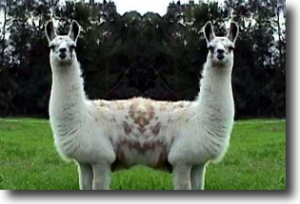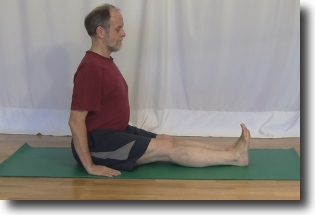A strange thing happens to Bob when he invokes the Baby Toe factor to get his legs setup properly in Dandasana. When he pulls his toes back towards his hips, the top of his hips moves back and down towards the floor. When he pulls his hips up straight his toes move further away from his hips. They were acting just like a “Push me Pull you” from the movie “Dr. Doolittle”.
Bob is trying desperately to establish the Baby Toe factor without rounding his back and he is stuck.
What is Dandasana
Dandasana is a seated pose that occurs quite often during a yoga practice. This is the pose that you are in when you are in between poses and it is the first pose of the Ashtanga Primary series.
Dandasana improves your posture stretches your chest and shoulder muscles while it strengthens your back.
There is no twisting or binding in this pose.
How to do Dandasana
You start out on the floor with your legs in front of you. Your legs are straight with your big toes touching and there is a slight gap between your heels.
As you inhale bring your hands to the floor beside your hips. Your wrists are on the floor in line with your sitz bones and your fingers are pointing straight ahead towards your feet.
Lower your shoulders down your back and lift your chest.
Your back is rising straight out of your hips and the back of your hips is rising straight up as well. There is no slouching in this pose.
Exhale and engage Uddiyana Bandha, tuck your chin in slightly and bring your gaze towards your big toes.
You hold here for several breaths before moving on to the next pose.
The Baby Toe factor insures that you have your legs properly setup for maximum benefit in Dandasana.
As you gaze at your big toe take a look at your baby toe to confirm that you are using the Baby Toe factor
What is the Baby Toe factor
When you look at your feet, you may discover that your baby toe is further away than your big toe. You are using the Baby Toe factor when your baby toe is in line with your big toe and both of them are the same distance away from your hips.
The Baby Toe factor insures that you have your legs properly setup for maximum benefit in Dandasana. Your baby toe controls how much of an inward rotation your legs have. It is real easy to invoke the Baby Toe factor.
How to do the Baby Toe factor
While looking at your feet, become aware of the alignment of your toes. All of your toes should be pulled back towards your hips. If your baby toe is further away than your big toe you need to do three things to fully invoke the Baby Toe factor.
- Turn your knees inwards slightly. This will cause some internal rotation in your thighs and hip joint wish will improve your hip flexibility over time.
- Once you turn your knees inwards, draw your little toes back towards you. All of your toes should be in line and at the same distance from your hips.
- The final step is to draw the top of your feet back towards your hips. Visualize that you have your feet against a wall. Your heels are pressed into the wall and your feet are rising straight up the wall. This is the position you are attempting to get your feet into.
When the Baby Toe factor is fully engaged, your feet will be rising straight up into the air, there will be a slight gap between your heels while your big toes are touching and your knees will be turned inward slightly as all of your toes pull back equally towards your hips.
Why do the Baby Toe factor
The benefit of the Baby Toe factor is that it sets up your legs properly for the pose.
When you pull your toes back towards your hips you are activating all of the muscles in your legs. This action both strengthens and stretches your leg muscles.
When you turn your knees inwards slightly you are working on creating additional flexibility in your hip joint. You are developing internal rotation of your thighs in your hip joint.
There is a problem with invoking the Baby Toe Factor as Bob discovered and it is your hamstrings
What to do when you lower back rounds
As Bob discovered when he invokes the Baby Toe factor his hips move backwards causing his back to round. Rather than sitting tall, Bob is slouching. This is not good for his lower back and abdomen.
There is something that Bob can do to get rid of this problem.
If Bob bends his knees and draws his heels a little closer to his hips he will be able to invoke the Baby Toe factor and still keep his hips vertical and his back straight.
Bob’s problem is caused by short hamstrings. Your hamstrings attach at the back of the hips and just below the knee joint on the shin. When Bob draws his toes towards his hips he is causing his hamstrings to engage and when they are short they draw the back of his hips down towards the floor. Bending his knees slightly eliminates this problem.
Summary
Dandasana is an easy pose to get into but it is a challenging pose to do for maximum benefit as Bob discovered.
The Baby Toe factor insures that your legs are setup properly with a slight inward rotation and that all of the muscles of your legs are engaged.
The Baby Toe factor can cause a problem with your lower back if you have short hamstrings. You can remove this problem by bending your knees up slightly.
Next Step
The next time you do Dandasana ask your teacher to check out your Baby Toe factor to insure that you get maximum benefit for your legs and avoid injury to your lower back.





